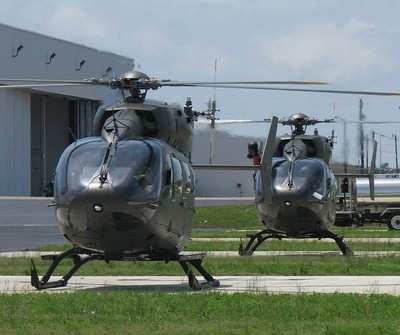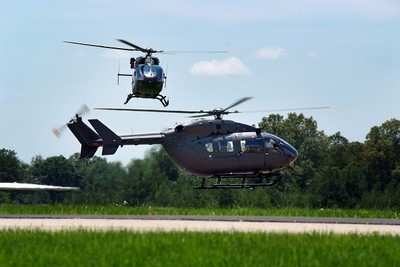U.S. Army Says The Light Utility Helo Is Important To Homeland
Security
The Army extended the presence of the UH-72A Lakota Helicopter
into the Military District of Washington, August 11, as it replaced
the UH-1 Iroquois Helicopter, or Huey, at Fort Belvoir's Davison
Army Airfield.

U.S. Army Photo
The Lakota light utility helicopter, a commercial aircraft
produced in Columbus, MS, is used by the Army to conduct homeland
security and give administrative and logistic support to training
centers. It began replacing the UH-60 Black Hawks in medical
evacuation missions when they were sent to Fort Irwin, CA, in
2007.
The helicopter has since been fielded at Fort Eustis, VA, Fort
Polk, LA, the U.S. Naval Test Pilot School in Maryland and the U.S.
Military Academy in New York. It's also being used outside of the
continental United States in Puerto Rico, the Marshall Islands and
by the Joint Multinational Readiness Center in Germany. "We're in
the process of setting standards in how quickly we can get critical
programs to our Soldiers in the field," said Col. Neil Thurgood,
the project manager for the Lakota helicopter.
One hundred thirteen helicopters have been fielded across the
military to both active-duty and National Guard units, with most
going to the Guard. "That's very important because it's part of our
nation's promise to the Guard to field them with current, modern
technology and to support them in their homeland defense missions,"
Thurgood said.
The Lakota continues to replace Black Hawks in non-combat
operations, which can then be sent to Iraq and Afghanistan for
missions. It also saves the Army money by easing maintenance issues
that older Hueys experience. The Lakota not only does a good job of
supporting the mission, but also helps eliminate the Army's fleet
of aging aircraft, Thurgood said. "Both are important for the
Army."

Army National Guard Photo
The Lakota can be used during search and rescue operations in
the aftermath of floods, earthquakes and other natural disasters.
It can also be used by the Army National Guard to perform
counter-narcotics operations at the border. But the primary mission
depends on the aircraft's configuration. The helicopter can be
crafted in five specific variations. There is a VIP variant to fly
senior leaders around; a MEDEVAC variant to conduct medical
missions; a training-specific modification; a Guard-specific
aircraft for homeland security; and a standard-package aircraft
used for a variety of missions. After 40,000 hours of flight time,
with 420 trained pilots, the feedback from operators is positive,
Thurgood said.
All Lakota pilots are provided with FAA training in Granbury,
Texas, and the impact the helicopter has on the country's economy
is an additional advantage. "The aircraft production has shifted
from Germany to America," Thurgood said. "That's very important
economically to our nation, it's very important to our jobs and
it's very important to our states."
The Army has taken steps to ensure a smooth fielding process, an
extensive mission set and encouraging feedback. These measures have
led to a successful implementation of the Lakota helicopter with
support from senior leaders. The process has been successful
because the Army is tied directly to users, forming a relationship
with every unit using the helicopter. Leadership has worked hard to
acquire funding leading to an accelerated program. And this is an
instance where the Army has taken advantage of the marketplace
instead of tasking industry with building a specific aircraft,
Thurgood said.
These factors have led to rapid acquisition, and the fielding
process isn't slowing down. The Army is set to field the Lakota at
Aberdeen Proving Ground and for National Guard units in Yakima, WA,
and Virginia for the remainder of the year.
Sixty-two Lakota helicopters will be sent to 12 different sites
next year.
 ANN's Daily Aero-Term (04.28.24): Airport Marking Aids
ANN's Daily Aero-Term (04.28.24): Airport Marking Aids Aero-News: Quote of the Day (04.28.24)
Aero-News: Quote of the Day (04.28.24) ANN's Daily Aero-Linx (04.28.24)
ANN's Daily Aero-Linx (04.28.24) Aero-News: Quote of the Day (04.29.24)
Aero-News: Quote of the Day (04.29.24) ANN's Daily Aero-Linx (04.29.24)
ANN's Daily Aero-Linx (04.29.24)




